Resistance Induction and Direct Antifungal Activity of Some Monoterpenes against Rhizoctonia solani, the Causal of Root Rot in Common Bean
Abstract
:1. Introduction
2. Materials and Methods
2.1. Chemicals
2.2. Isolation, Purification, and Identification of Pathogenic Fungus
2.3. In Vitro Antifungal Action of the Used Monoterpenes against R. solani
2.4. Efficacy of the Tested Monoterpenes against Root Rot of Common Bean under Greenhouse Conditions
2.5. Efficacy of the Tested Monoterpenes against Root Rot of Common Bean under Field Conditions
2.6. Efficacy of the Tested Monoterpenes on Growth and Yield Parameters of Common Bean under Field Conditions
2.7. Effect of the Tested Monoterpenes on Defense Enzymes
2.8. Analysis of Defense Related Genes Expression in Common Bean Plants Treated with the Tested Monoterpenes
2.9. Data Analysis
3. Results
3.1. Antifungal Activity of Monoterpenes against R. solani under Laboratory Conditions
3.2. Systemic Protection against Root Rot Disease in Common Bean under Greenhouse Conditions
3.3. Systemic Protection against Root Rot Disease in Common Bean under Filed Conditions
3.4. Effect of Monoterpenes on Bean Growth and Yield
3.5. Effect of Monoterpenes of Defense Enzymes Activities
3.6. Effect of Monoterpenes on the Expression of Defense-Related Genes in Treated Common Bean Plants
4. Discussion
5. Conclusions
Author Contributions
Funding
Institutional Review Board Statement
Informed Consent Statement
Data Availability Statement
Acknowledgments
Conflicts of Interest
References
- Jackson, J.; Kinabo, J.; Mamiro, P.; Mamiro, D.; Jideani, V. Utilization of Dry Beans and Pulses in Africa. In Dry Beans and Pulses Production, Processing and Nutrition; Siddiq, M., Uebersax, M.A., Eds.; Blackwell: Oxford, UK, 2012; pp. 261–282. [Google Scholar]
- Costa, J.M.; Argolo, A.M.; Felix, M. Redescription of Triatoma melanica Neiva & Lent, 1941, new status (Hemiptera: Reduviidae: Triatominae). Zootaxa 2006, 1385, 47–52. [Google Scholar]
- FAOSTAT© FAO. Statistics Division. Statistical Yearbook of the Food and Agricultural Organization-FAO. 2017. Available online: www.fao.org/3/i3107e/i3107e03 (accessed on 23 January 2022).
- Gupta, S.; Sharma, D.; Gupta, M. Climate change impact on plant diseases: Opinion, rends and mitigation strategies. In Microbes for Climate Resilient Agriculture; Kashyap, P.L., Srivastava, A.K., Tiwari, S.P., Kumar, S., Eds.; John Wiley & Sons, Inc.: Hoboken, NJ, USA, 2018; pp. 41–56. Available online: https://onlinelibrary.wiley.com/doi/abs/10.1002/9781119276050.ch3 (accessed on 24 March 2022).
- Singh, S.P.; Schwartz, H.F. Breeding common bean for resistance to diseases: A review. Crop Sci. 2010, 50, 2199. [Google Scholar] [CrossRef]
- Ogoshi, A. Studies on the grouping of Rhizoctonia solani Kuhn with hyphal anastomosis, and on the perfect stage of groups. Bull. Natl. Inst. Agric. Sci. Ser. C 1976, 30, 1–63. [Google Scholar]
- Abawi, G.S.; Crosier, D.C.; Cobb, A.C. Root rot of snap bean in New York. N. Y. Food Life Sci. Bull. 1985, 110, 362–369. [Google Scholar]
- El-Mougy, S.N.; Nadia, G.E.; Abdel-Kader, M.M. Control of wilt and root rot/incidence in Phaseolus vulgaris L. By some plant volatile compounds. J. Plant Prot. Res. 2007, 47, 255–265. [Google Scholar]
- Arya, A.; Perelló, A.E. Management of Fungal Plant Pathogens. In Google eBook; 2010; Available online: https://www.cabi.org/bookshop/book/9781845936037/ (accessed on 20 February 2022).
- Costa, T.R.; Fernandes, F.L.F.; Santos, S.C.; Oliveria, C.M.A.; Liao, L.M.; Ferri, P.H.; Paulo, J.R.; Ferreira, H.D.; Sales, B.H.N.; Silva, M.R.R. Antifungal activity of volatile constituents of Eugenia dysenterica leaf oil. J. Ethnopharmcol. 2000, 72, 111–117. [Google Scholar] [CrossRef]
- Elsharkawy, M.M.; El-Sawy, M.M. Control of bean common mosaic virus by plant extracts in bean plants. Inter. J. Pest Manag. 2015, 61, 54–59. [Google Scholar] [CrossRef]
- Hamza, A.; Mohamed, A.; Derbalah, A. Unconventional alternatives for control of tomato root rot caused by Rhizoctonia solani under greenhouse conditions. J. Plant Protect. Res. 2016, 56, 298–305. [Google Scholar] [CrossRef] [Green Version]
- Grodnitzky, J.A.; Coats, J.R. QSAR evaluation of monoterpenoids insecticidal activity. J. Agric. Food Chem. 2002, 50, 4576–4580. [Google Scholar] [CrossRef] [Green Version]
- Cantore, P.L.; Shanmugaiah, V.; Iacobellis, N.S. Antibacterial activity of essential oil components and their potential use in seed disinfection. J. of Agric. and Food Chem. 2009, 57, 9454–9461. [Google Scholar] [CrossRef]
- Duke, S.O.; Romagni, J.G.; Dayan, F.E. Natural products as sources for new mechanisms of herbicidal action. Crop Protect. 2000, 19, 583–589. [Google Scholar] [CrossRef]
- Wuryatmo, E.; Klieber, A.; Scott, E. Inhibition of citrus post-harvest pathogens by vapor of citral and related compounds in culture. J. Agric. Food Chem. 2003, 51, 2637–2640. [Google Scholar] [CrossRef] [PubMed]
- Tsao, R.; Zhou, T. Antifungal activity of monoterpenoids against postharvest pathogens Botrytis cinerea and Monilinia fructicola. J. Essent. Oil Res. 2000, 12, 113–121. [Google Scholar] [CrossRef]
- Kordali, S.; Kotan, R.; Cakir, A. Screening of antifungal activities of 21 oxygenated monoterpenes in-vitro as plant disease control agents. Allelopathy J. 2007, 19, 373–392. [Google Scholar]
- Kordali, S.; Cakir, A.; Ozer, H.; Cakmakci, R.; Kesdek, M.; Mete, E. Antifungal, phytotoxic and insecticidal properties of essential oil isolated from Turkish Origanum acutidens and its three components, carvacrol, thymol and p-cymene. Bioresour. Technol. 2008, 99, 8788–8795. [Google Scholar] [CrossRef] [PubMed]
- Hartmans, K.J.; Diepenhorst, P.; Bakker, W.; Gorris, L.G.M. The use of carvone in agriculture: Sprout suppression of potatoes and antifungal activity against potato tuber and other plant diseases. Indust. Crops Prod. 1995, 4, 3–13. [Google Scholar] [CrossRef]
- Garcia, R.; Alves, E.S.S.; Santos, M.P.; Viegas Aquije, G.M.F.; Fernandes, A.A.R.; Dos Santos, R.B.; Ventura, J.A.; Fernandes, P.M.B. Antimicrobial activity and potential use of monoterpenes as tropical fruits preservatives. Braz. J. Microbiol. 2008, 39, 163–168. [Google Scholar] [CrossRef] [Green Version]
- Sneh, B.; Jabaji-Hare, S.; Neate, S.M.; Dijst, G. (Eds.) Rhizoctonia Species: Taxonomy, Molecular Biology, Ecology, Pathology and Disease Control; Springer: Berlin/Heidelberg, Germany, 1991. [Google Scholar]
- Allen, O.N. Experiments in Soil Bacteriology; Burgess Publishing Co.: Newark, NJ, USA, 1950. [Google Scholar]
- Elsharkawy, M.M.; El-Khateeb, N.M. Antifungal activity and resistance induction against Sclerotium cepivorum by plant growth-promoting fungi in onion plants. Egypt. J. Biol. Pest Control. 2019, 29, 68. [Google Scholar] [CrossRef]
- Wang, Q.; Xiong, D.; Zhao, P.; Yu, X.; Tu, B.; Wang, G. Effect of applying an arsenic-resistant and plant growth–promoting rhizobacterium to enhance soil arsenic phytoremediation by Populus deltoids LH05-17. J. Appl. Microbiol. 2011, 111, 1065–1074. [Google Scholar] [CrossRef]
- Wen, K.; Seguin, P.; St.-Arnaud, M.; Jabaji-Hare, S. Real-time quantitative RT-PCR of defense-associated gene transcripts of Rhizoctonia solani-infected bean seedlings in response to inoculation with a nonpathogenic binucleate Rhizoctonia isolate. Phytopathology 2005, 95, 345–353. [Google Scholar] [CrossRef] [Green Version]
- Khalifa, E.Z. Further Studies on Some Soil-Borne Fungi Affecting Soybean and Their Control. Ph.D. Thesis, Faculty of Agriculture, Menoufiya University, Al Minufya, Egypt, 1987; p. 148. [Google Scholar]
- Rewal, H.S.; Jhooty, J.S. Differential response of wheat varieties to systemic fungitoxicants applied to Ustilago tritici (Pers.). Rostr. Indian J. Agric. Sci. 1985, 55, 548–549. [Google Scholar]
- Hammerschmidt, R.; Nuckles, E.M.; Kuc, J. Association of enhanced peroxidase activity with induced systemic resistance of cucumber to Colletotrichum lagenarium. Physiol. Plant Pathol. 1982, 20, 73–82. [Google Scholar] [CrossRef]
- Mayer, A.M.; Harel, E.; Shaul, R.B. Assay of catechol oxidase, a critical comparison methods. Phytochemistry 1965, 5, 783–789. [Google Scholar] [CrossRef]
- Saravanakumar, D.; Kavino, M.; Raguchander, T.; Subbian, P.; Samiyappan, R. Plant growth promoting bacteria enhance water stress resistance in green gram plants. Acta Physiol. Plant 2011, 33, 203–209. [Google Scholar] [CrossRef]
- Livak, K.J.; Schmittgen, T.D. Analysis of relative gene expression data using real-time quantitative PCR and the 2−CT method. Method 2001, 25, 402–408. [Google Scholar] [CrossRef]
- Morcia, C.; Malnati, M.; Terzi, V. In vitro antifungal activity of terpinen-4-ol, eugenol, carvone, 1,8-cineole (eucalyptol) and thymol against mycotoxigenic plant pathogens. Food Addit. Contam. Part A 2011, 29, 1–8. [Google Scholar] [CrossRef] [Green Version]
- Marei, G.I.K.; Abdel Rasoul, M.A.; Abdelgaleil, S.A.M. Comparative antifungal activities and biochemical effects of monoterpenes on plant pathogenic fungi. Pestic. Biochem. Physiol. 2012, 103, 56–61. [Google Scholar] [CrossRef]
- Nazzaro, F.; Fratianni, F.; Coppola, R.; De Feo, V. Essential oils and antifungal activity. Pharmaceuticals 2017, 10, 86. [Google Scholar] [CrossRef] [Green Version]
- Plodpai, P.; Chuenchitt, S.; Petcharat, V.; Chakthong, S.; Voravuthikunchai, S.P. Anti-Rhizoctonia solani activity by Desmos chinensis extracts and its mechanism of action. Crop Protec. 2013, 43, 65–71. [Google Scholar] [CrossRef]
- Abdel-Monaim, M.F.; Abo-Elyousr, K.A.M.; Morsy, K.M. Effectiveness of plant extracts on suppression of damping-off and wilt diseases of lupine (Lupinus termis Forsik). Crop Protec. 2011, 30, 185–191. [Google Scholar] [CrossRef]
- Kagale, S.; Marimuthu, T.; Kagale, J.; Thayumanavan, B.; Samiyappan, R. Induction of systemic resistance in rice by leaf extracts of Zizyphus jujuba and Ipomoea carnea against Rhizoctonia solani. Plant Signal. Behav. 2011, 6, 919–923. [Google Scholar] [CrossRef] [PubMed] [Green Version]
- Idrees, M.; Naeem, M.; Aftab, T.; Khan, M.M.A.; Moinuddin, A.S. Salicylic acid mitigates salinity stress by improving antioxidant defense system and enhances vincristine and vinblastine alkaloids production in periwinkle [Catharan thusroseus (L.) G. Don]. Acta Physiol. Plant 2011, 33, 987–999. [Google Scholar] [CrossRef]
- Kiefer, I.W.; Slusarenko, A.J. The pattern of systemic acquired resistance induction within the Arabidopsis rosette in relation to the pattern of translocation. Plant Physiol. 2003, 132, 840–847. [Google Scholar] [CrossRef] [PubMed] [Green Version]
- Gwinn, K.D.; Ownley, B.H.; Greene, S.E.; Clark, M.M.; Taylor, C.L.; Springfield, T.N.; Trently, D.J.; Green, J.F.; Reed, A.; Hamilton, S.L. Role of essential oils in control of Rhizoctonia damping-off in tomato with bioactive Monarda herbage. Phytopathology 2010, 100, 493–501. [Google Scholar] [CrossRef] [Green Version]
- Abdel-Mawgoud, A.M.R.; Tantawy, A.S.; Magda Hafez, M.; Hoda Habib, A.M. Seaweed extract improves growth, yield and quality of different watermelon hybrids. Res. J. Agric. Biol. Sci. 2010, 6, 161–186. [Google Scholar]
- Shehata, S.M.; Abdel-Azem, H.S.; Abou El-Yazied, A.; El-Gizawy, A.M. Effect of foliar spraying with amino acids and seaweed extract on growth, chemical constitutes, yield and its quality of Celeriac plant. Europ. J. Sci. Res. 2011, 58, 257–265. [Google Scholar]
- Fawzy, Z.F.; El-Shal, Z.S.; Yunsheng, L.; Ouyang, Z.; Sawan, M.O. Response of garlic (Allium sativum, L.) plants to foliar spraying of some bio-stimulants under sandy soil condition. J. Appl. Sci. Res. 2012, 8, 770–776. [Google Scholar]
- Hernández, R.M.H.; Santacruz, F.; Ruiz-López, M.A.; Norrie, J.; Hernández-Carmona, G. Effect of liquid seaweed extracts on growth of tomato seedlings (Solanum lycopersicum L.). J. Appl. Phycol. 2014, 26, 619–628. [Google Scholar] [CrossRef]
- Cook, N.C.; Samman, S. Flavonoids chemistry, metabolism, cardio protective effect and dietary sources. J. Nutr. Bio. 1996, 7, 66–76. [Google Scholar] [CrossRef]
- Sažetak, A. Greenhouse pepper, natural biostimulants, phenolic content, pigments, vitamin C, antioxidant activity. J. Sci. Food Agric. 2011, 91, 2146–2152. [Google Scholar]
- Fathy, S.S.; Moghasy, A.M.; El-Nagar, M.E.; Tolba, M.H. Effect of some natural essential oil on cowpea productivity and storability. J. Agric. Sci. Mansoura Univ. 2008, 33, 8057–8070.52. [Google Scholar]
- Hassan, H.M.; Ahmed, O.K.; El-Shemy, H.A.; Afify, A.S. Palm pollen extracts as plant growth substances for banana tissue culture. World J. Agric. Sci. 2008, 4, 514–520. [Google Scholar]
- Amal, A.M.; El-Emary, A.G.; Ali, H.F. Influence of some citrus essential oils on cell viability, glutathione-stransferase and lipid peroxidation in Ehrlich ascites carcinoma cell. J. Am. Sci. 2010, 6, 820–826. [Google Scholar]
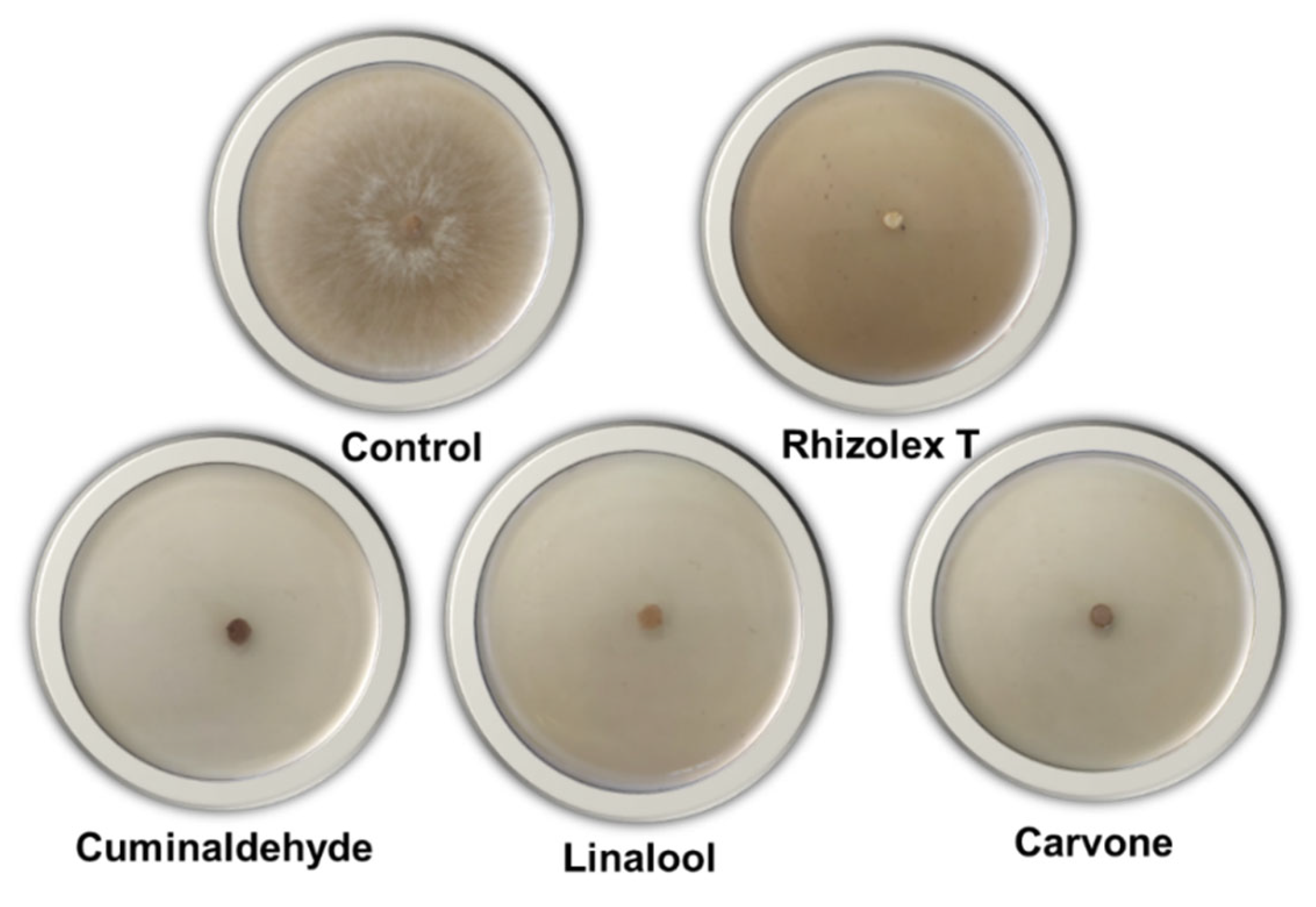
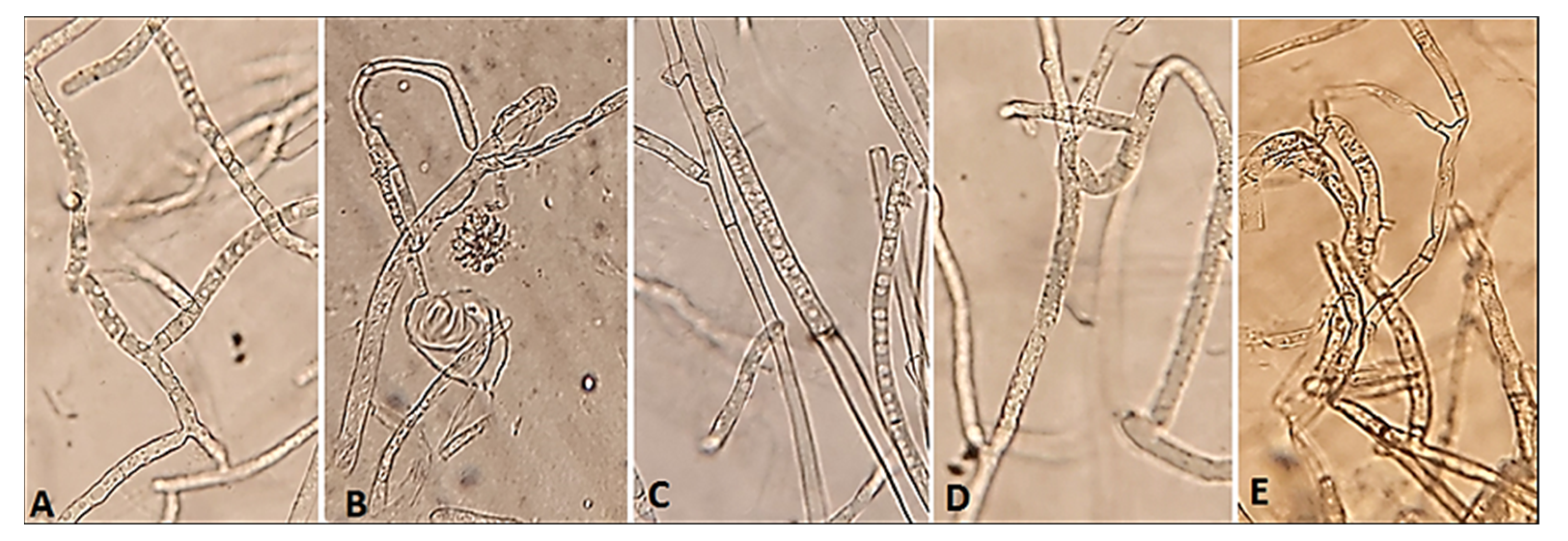
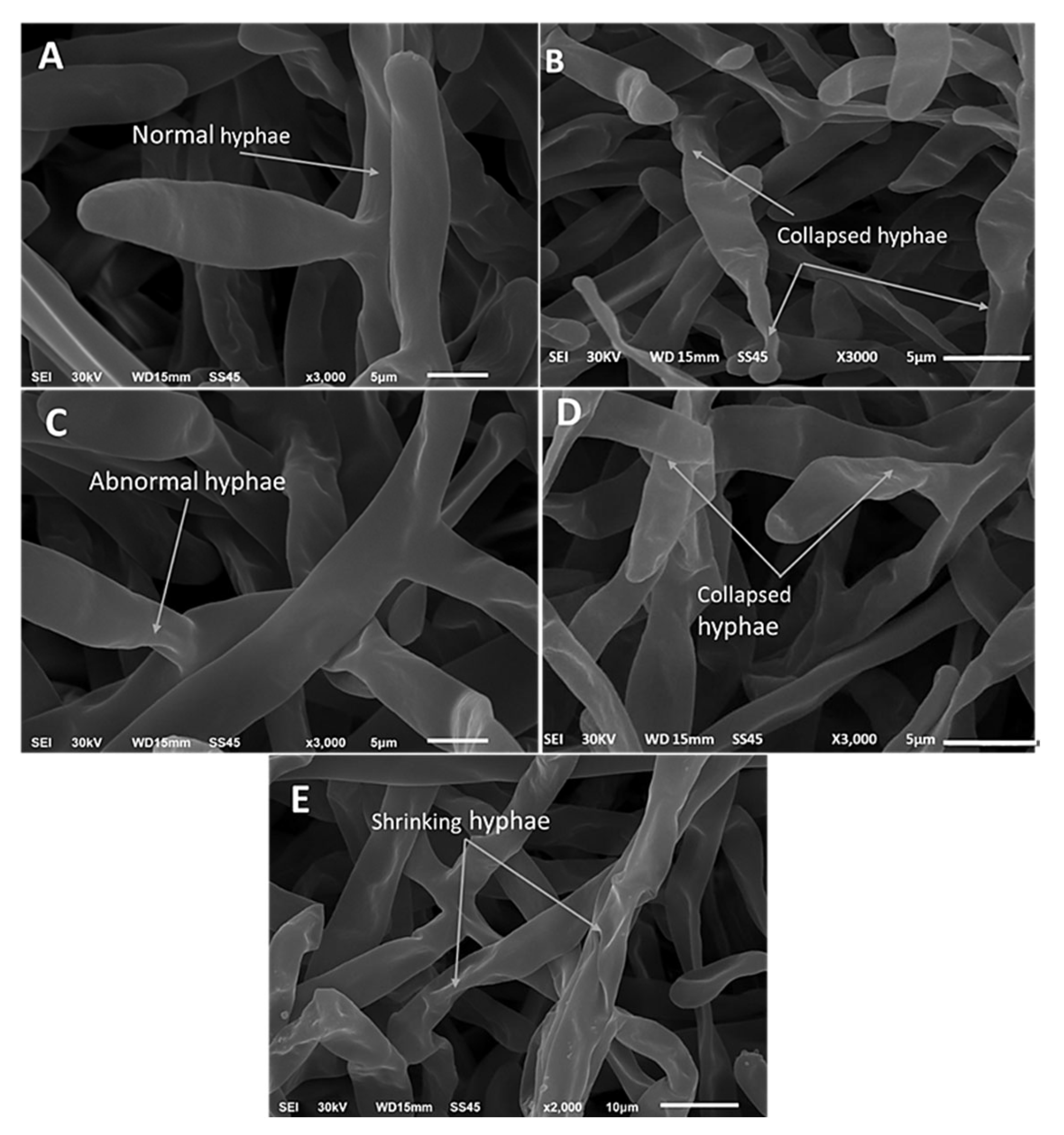
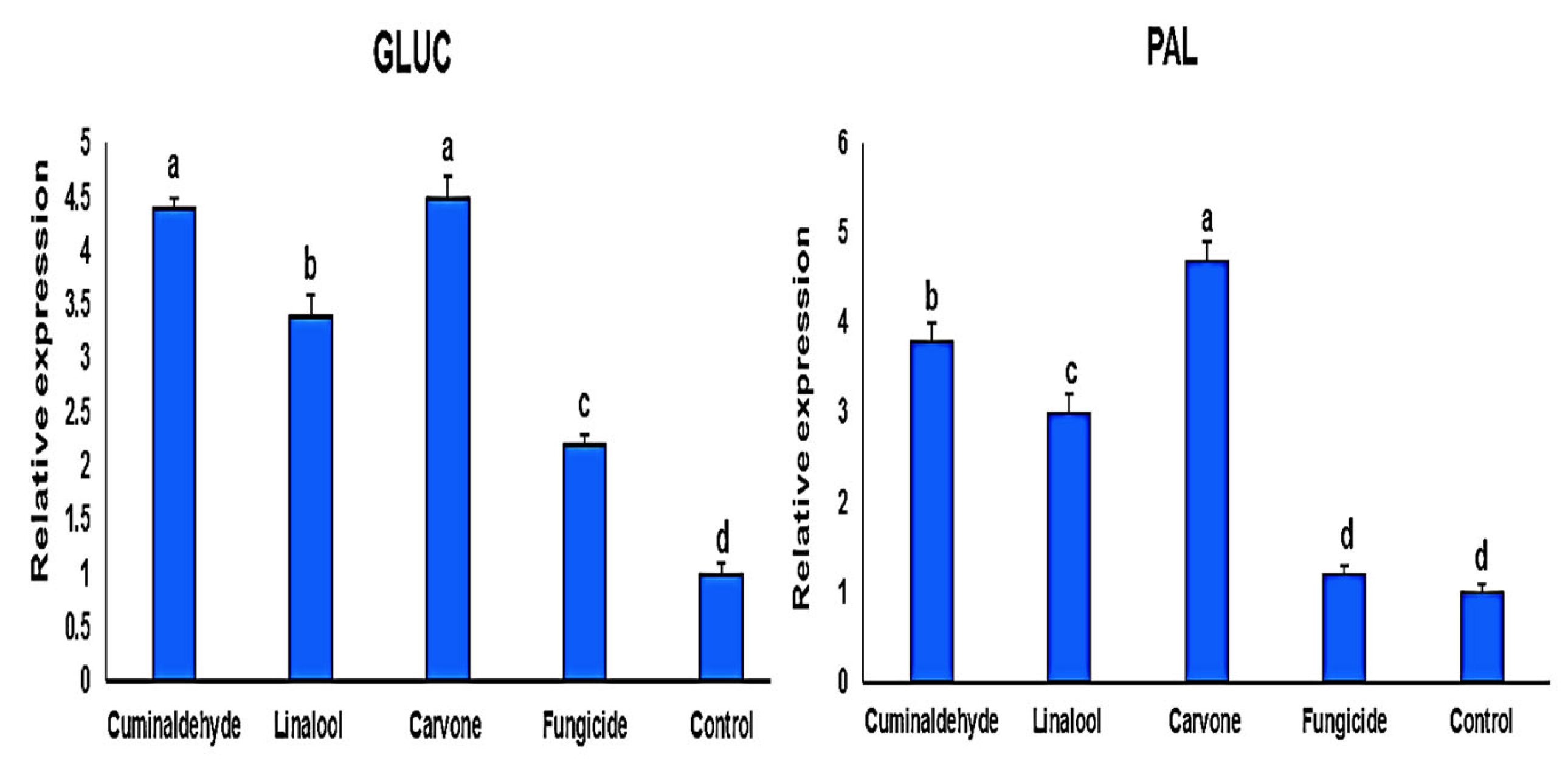
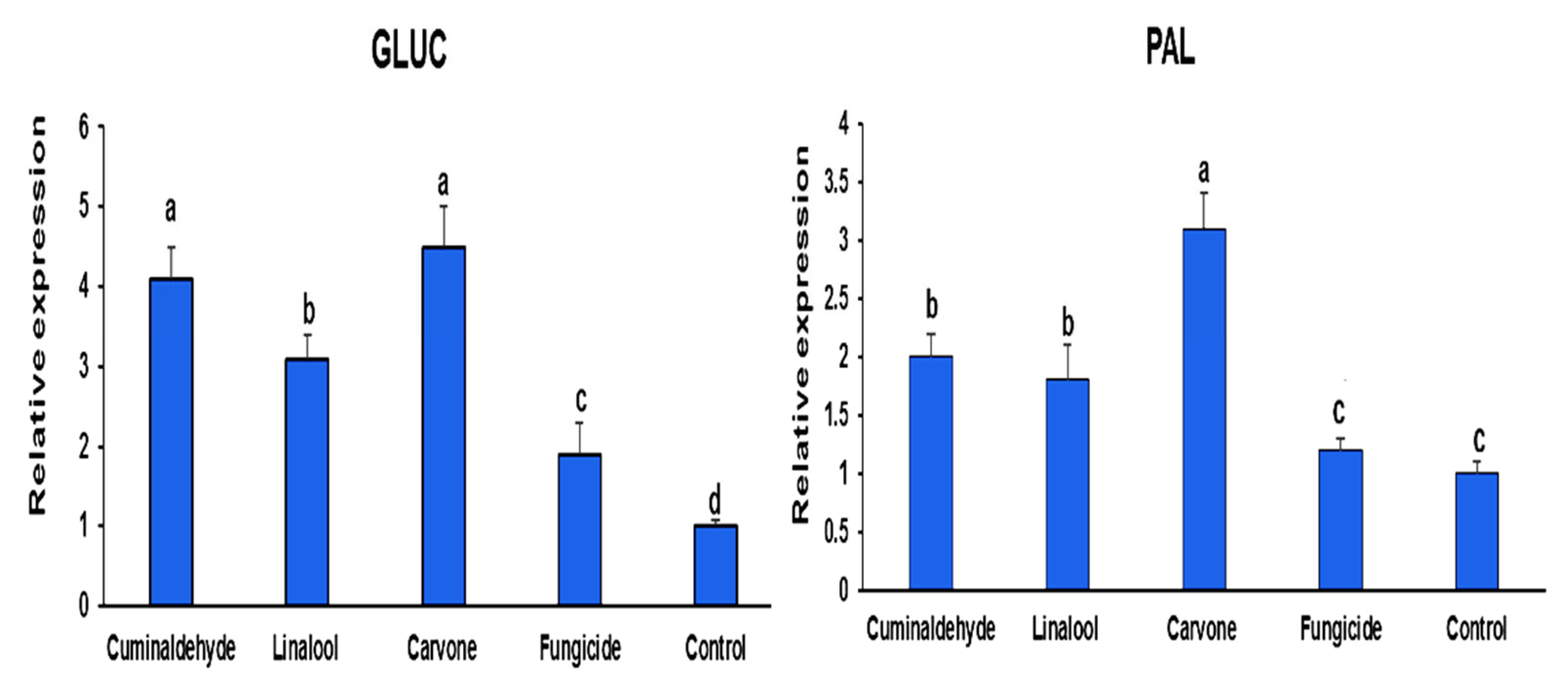
| Primer Name | Forward Primer (5′–3′) | Reverse Primer (5′–3′) | Accession Number | Product Size (pb) |
|---|---|---|---|---|
| GLUC | GCTGTAAGGGCTCAAGGCCTC | CCAAGTACACACGTGCGTTGTC | X53129 | 427 |
| PAL | AAGCCATGTCCAAAGTGCTG | GAGTTCTCCGTTGCCACCT | M11939 | 240 |
| ACTIN | CACCGAGGCACCGCTTAATC | CGGCCACTAGCGTAAAGGGAA | AB067722 | 126 |
| Treatments | Concentration (µg/mL) | Linear Growth (cm) | Growth Inhibition % | Regression Equation | R² |
|---|---|---|---|---|---|
| Cuminaldehyde | 10 | 7.2 ± 1.3 b | 20 | y = 0.8776x + 10.51 | 0.99 |
| 20 | 6.3 ± 1.2 b | 30 | |||
| 50 | 4.5 ± 0.9 c | 50 | |||
| 100 | 0.0 ± 0.0 f | 100 | |||
| Linalool | 10 | 7.4 ± 1.2 b | 18 | y = 0.9276x + 9.0102 | 0.99 |
| 20 | 6.8 ± 1.1 b | 25 | |||
| 50 | 3.3 ± 0.7 d | 60 | |||
| 100 | 0.0 ± 0.0 f | 100 | |||
| Carvone | 10 | 4.9 ± 0.8 c | 45 | y = 0.5969x + 41.888 | 0.99 |
| 20 | 4.1 ± 0.7 c | 55 | |||
| 50 | 2.3 ± 0.7 e | 75 | |||
| 100 | 0.0 ± 0.0 f | 100 | |||
| Rhizolex T | 55 | 4.1 ± 0.9 c | 55 | y = 0.4796x + 53.418 | 0.98 |
| 65 | 3.2 ± 79 d | 65 | |||
| 80 | 1.8 ± 0.6 e | 80 | |||
| 100 | 0.0 ± 0.0 f | 100 | |||
| Control | 0.00 | 9.0 ± 1.4 a | 0.00 | - | - |
| Treatment | Damping-Off % | DI% | ||
|---|---|---|---|---|
| Pre-Emergence | Post-Emergence | Survival | ||
| Cuminaldehyde | 37.7 b ± 0.23 | 0.0 e ± 0.00 | 63.3 b ± 0.72 | 22.2 d ± 1.03 |
| Linalool | 37.7 b ± 0.28 | 3.3 d ± 0.38 | 60.0 b ± 0.74 | 31.6 b ± 1.07 |
| Carvone | 23.4 c ± 0.19 | 13.3 a ± 0.42 | 63.3 b ± 0.77 | 26.3 c ± 1.08 |
| Fungicide | 10.0 d ± 0.17 | 6.67 c ± 0.32 | 83.3 a ± 0.79 | 20.0 e ± 0.99 |
| Control | 56.7 a ± 0.24 | 10.0 b ± 0.31 | 33.3 c ± 0.71 | 50.0 a ± 1.04 |
| L.S.D | 4.346 | 2.726 | 3.495 | 1.262 |
| Treatment | Damping-Off % | DI% | % Efficacy | ||
|---|---|---|---|---|---|
| Pre-Emergence | Post-Emergence | Survival | |||
| Kafr Elsheikh governorate | |||||
| Cuminaldehyde | 22.3 c ± 0.33 | 17.3 c ± 0.43 | 60.4 c ± 0.72 | 26.8 c ± 1.12 | 55.48 ± 2.23 |
| Linalool | 23.2 c ± 0.34 | 21.9 b ± 0.44 | 54.9 d ± 0.74 | 34.2 b ± 1.18 | 42.3 ± 2.29 |
| Carvone | 17.7 b ± 0.32 | 13.3 d ± 0.42 | 69.0 b ± 0.71 | 23.7 d ± 1.18 | 60.0 ± 2.28 |
| Fungicide | 12.0 a ± 0.35 | 7.7 e ± 0.43 | 80.3 a ± 0.77 | 18.9 e ± 1.17 | 68.1 ± 2.21 |
| Control | 34.8 d ± 0.38 | 34.3 a ± 0.41 | 30.9 e ± 0.78 | 59.3 a ± 1.21 | 0.00 |
| L.S.D | 2.214 | 2.328 | 2.973 | 3.298 | -- |
| Gharbia governorate | |||||
| Cuminaldehyde | 24.6 b ± 0.34 | 18.2 c ± 0.45 | 57.2 c ± 0.75 | 28.2 c ± 1.19 | 54.3 ± 2.28 |
| Linalool | 28.2 b ± 0.37 | 23.2 b ± 0.43 | 48.6 d ± 0.78 | 36.4 b ± 1.21 | 41.0 ± 2.32 |
| Carvone | 19.3 c ± 0.31 | 12.1 d ± 0.47 | 68.6 b ± 0.74 | 21.3 d ± 1.19 | 65.5 ± 2.30 |
| Fungicide | 13.2 d ± 0.39 | 6.8 e ± 0.45 | 80.0 a ± 0.79 | 17.8 e ± 1.20 | 71.2 ± 2.28 |
| Control | 36.4 a ± 0.34 | 37.2 a ± 0.44 | 26.4 e ± 0.74 | 61.7 a ± 1.23 | 0.00 |
| L.S.D | 2.434 | 2.551 | 3.271 | 3.418 | -- |
| Treatment | Growth Parameters | |||
|---|---|---|---|---|
| Plant Height (cm) | Branches No./Plant | Fresh Weight (g)/Plant | Dry Weight (g)/Plant | |
| Kafr Elsheikh governorate | ||||
| Cuminaldehyde | 47.4 b ± 1.21 | 5.2 b ± 0.74 | 79.3 b ± 2.10 | 10.4 a ± 0.98 |
| Linalool | 44.9 c ± 1.23 | 4.8 b ± 0.72 | 74.8 c ± 2.12 | 9.8 ab ± 0.94 |
| Carvone | 48.1 b ± 1.11 | 5.7 a ± 0.83 | 80.3 b ± 2.01 | 10.8 a ± 1.03 |
| Fungicide | 50.2 a ± 1.13 | 5.9 a ± 0.89 | 82.4 a ± 2.11 | 11.4 a ± 1.00 |
| Control | 34.5 d ± 1.17 | 3.2 c ± 0.92 | 41.1 d ± 1.99 | 5.3 c ± 1.01 |
| L.S.D | 1.438 | 0.423 | 2.327 | 0.612 |
| Gharbia governorate | ||||
| Cuminaldehyde | 45.8 b ± 1.23 | 4.8 b ± 0.71 | 77.1 b ± 2.14 | 10.0 b ± 0.98 |
| Linalool | 43.4 c ± 1.22 | 4.5 b ± 0.73 | 73.3 c ± 2.13 | 9.2 c ± 0.97 |
| Carvone | 47.3 b ± 1.17 | 5.5 a ± 0.80 | 78.9 b ± 2.12 | 10.3 b ± 1.11 |
| Fungicide | 48.3 a ± 1.15 | 5.7 a ± 0.88 | 81.2 a ± 2.17 | 11.0 a ± 1.10 |
| Control | 32.9 d ± 1.19 | 3.1 c ± 0.97 | 40.2 d ± 2.12 | 5.1 d ± 1.12 |
| L.S.D | 1.393 | 0.372 | 2.429 | 0.727 |
| Treatment | Yield Parameters | |||
|---|---|---|---|---|
| No. Pods/Plant | Pods Weight (g)/Plant | Production/Hectare (ton) | Percentage of Yield Increase | |
| Kafr Elsheikh governorate | ||||
| Cuminaldehyde | 17.6 b ± 1.23 | 19.13 ab ± 1.4 | 2.80 ab ± 0.21 | 35.7 ± 1.91 |
| Linalool | 15.3 c ± 1.33 | 17.51 c ± 1.32 | 2.61 b ± 0.23 | 31.3 ± 1.93 |
| Carvone | 18.7 b ± 1.24 | 20.11 a ± 1.33 | 2.88 a ± 0.21 | 38.9 ± 1.98 |
| Fungicide | 20.2 a ± 1.32 | 21.21 a ± 1.34 | 3.02 a ± 0.22 | 42.1 ± 1.94 |
| Control | 9.3 d ± 1.34 | 12.30 d ± 1.29 | 1.76 c ± 0.24 | 0.0 |
| L.S.D | 1.437 | 1.082 | 0.132 | -- |
| Gharbia governorate | ||||
| Cuminaldehyde | 15.2 b ± 1.23 | 17.4 b ± 1.4 | 2.21 b ± 0.21 | 163.5 ± 1.91 |
| Linalool | 14.1 c ± 1.33 | 16.7 c ± 1.32 | 2.11bc ± 0.23 | 134.7 ± 1.93 |
| Carvone | 17.2 a ± 1.24 | 18.4 b ± 1.33 | 2.64 b ± 0.21 | 215.4 ± 1.98 |
| Fungicide | 18.3 a ± 1.32 | 20. 1 a ± 1.34 | 3.07 a ± 0.22 | 266.7 ± 1.94 |
| Control | 8.8 d ± 1.34 | 11.4 d ± 1.32 | 0.83 d ± 0.24 | 0.00 |
| L.S.D | 1.548 | 1.082 | 0.178 | -- |
| Treatment | Enzymatic Activities | ||
|---|---|---|---|
| CAT mM H2O2 g−1 FW Min−1 | POX mM H2O2 g−1 FW Min−1 | PPO µ mol/min−1 g−1 (FW) | |
| Cuminaldehyde | 32.4 a ± 2.21 | 0.871 a ± 0.08 | 0.143 b ± 0.02 |
| Linalool | 27.3 b ± 2.23 | 0.643 b ± 0.09 | 0.139 c ± 0.01 |
| Carvone | 33.2 a ± 2.32 | 0.989 a ± 0.08 | 0.155 a ± 0.03 |
| Fungicide | 21.3 c ± 2.22 | 0.497 c ± 0.07 | 0.117 d ± 0.02 |
| Control | 11.2 d ± 2.34 | 0.323 d ± 0.09 | 0.098 e ± 0.03 |
| L.S.D | 1.034 | 0.102 | 0.011 |
Publisher’s Note: MDPI stays neutral with regard to jurisdictional claims in published maps and institutional affiliations. |
© 2022 by the authors. Licensee MDPI, Basel, Switzerland. This article is an open access article distributed under the terms and conditions of the Creative Commons Attribution (CC BY) license (https://creativecommons.org/licenses/by/4.0/).
Share and Cite
Derbalah, A.; Shebl, A.M.; Elgobashy, S.F.; Ahmad, A.A.; Ramadan, N.E.; Behiry, S.I.; Abdelkhalek, A.; Saleem, M.H.; Al-Askar, A.A.; Kamran, M.; et al. Resistance Induction and Direct Antifungal Activity of Some Monoterpenes against Rhizoctonia solani, the Causal of Root Rot in Common Bean. Life 2022, 12, 1040. https://doi.org/10.3390/life12071040
Derbalah A, Shebl AM, Elgobashy SF, Ahmad AA, Ramadan NE, Behiry SI, Abdelkhalek A, Saleem MH, Al-Askar AA, Kamran M, et al. Resistance Induction and Direct Antifungal Activity of Some Monoterpenes against Rhizoctonia solani, the Causal of Root Rot in Common Bean. Life. 2022; 12(7):1040. https://doi.org/10.3390/life12071040
Chicago/Turabian StyleDerbalah, Aly, Asmaa Mohamed Shebl, Samah Fawzy Elgobashy, Abdelmonim Ali Ahmad, Noha Eldesoky Ramadan, Said I. Behiry, Ahmed Abdelkhalek, Muhammad Hamzah Saleem, Abdulaziz A. Al-Askar, Muhammad Kamran, and et al. 2022. "Resistance Induction and Direct Antifungal Activity of Some Monoterpenes against Rhizoctonia solani, the Causal of Root Rot in Common Bean" Life 12, no. 7: 1040. https://doi.org/10.3390/life12071040










